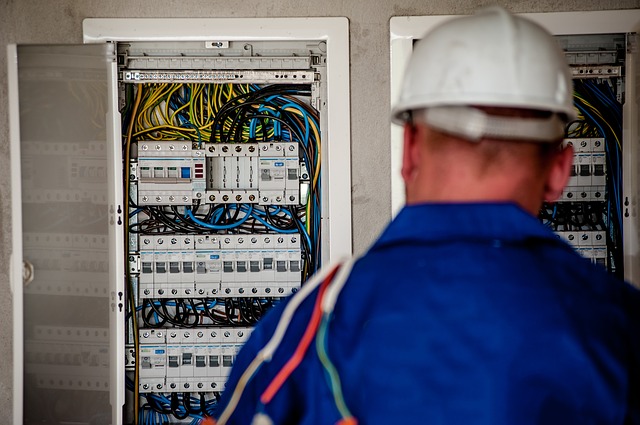Electrical system
Contents |
[edit] Introduction
An electrical system, within the context of a building, is a network of conductors and equipment designed to carry, distribute and convert electrical power safely from the point of delivery or generation to the various loads around the building that consume the electrical energy.
The vast majority of electrical systems used in buildings in the UK operate at 230V single phase alternating current (AC) or 400V 3 phase, at a frequency of 50Hz. These networks are often referred to as low voltage (LV) networks. This system is also referred to as mains electricity.
Larger installations may operate at higher voltages, often with 11kV supplies or feeders at the origin of the installation. These networks are referred to as high voltage (HV) networks.
Power conversion from 11kV networks down to the 230V-400V range is usually undertaken via transformers in a substation.
[edit] Conductors
The conductors that form part of the electrical system are the means by which electricity is transferred from one place to another. Typically, conductors are made from copper, which offers a good balance between electrical conductivity and cost. Aluminium may also be used in some instances. Conductors are typically insulated with PVC or other synthetic insulating materials.
Most conductors are used in the form of electrical cables. These can be run either separately or within containment systems between two points of an electrical system.
Other conductors commonly used in electrical systems in buildings are busbars. These are usually copper or aluminium conductors and run within an insulating and safety enclosure, typically a trunking. These may be used where larger conductors are required, as the busbar trunking is often physically smaller than cables of equivalent current carrying capacity. Such busbar trunking is usually made up of rigid lengths, and may have several tapping points, where supplies may be tapped or branched off.
[edit] Switchgear
As well as conductors, an electrical system will also comprise equipment that provides switching and protection capabilities, known as switchgear. Switchgear enables with manual or automated control of current flow.
Manual control relies on human intervention to work smoothly and is typically employed for isolation switching and functional switching.
Automatic switching may be based on protection characteristics for devices that detect excess current flow and act to prevent damage to cabling that may lead to fire and/or electric shock. This is usually achieved through the use of circuit breakers and/or fuses.
Automatic switching may also be handled by control systems, where electrical signalling from other systems is used to control devices known as relays or contactors, which in turn control higher power circuits.
[edit] Load devices
The final components of an electrical system are referred to as load devices. These convert electrical energy into other forms of energy such as heat, light, or movement.
Examples of these include common items such as light fittings (luminaires), motors, electric heating units, as well as power conversion equipment which converts mains electricity to lower voltages to run appliances and electronic equipment. Often such power conversion is done within the appliance or load itself.
--ECA
[edit] Related articles on Designing Buildings Wiki
- Articles about electricity.
- BEAMA.
- Competition and the independent electric wholesalers.
- ECA articles.
- Electric.
- Electrical appliance.
- Electrical consumption.
- Electrical energy.
- Electrical equipment.
- Electrical installation.
- Electrical power.
- Electrical safety.
- Electrician.
- Electricity bill.
- Mains electricity.
Featured articles and news
Design and construction industry podcasts
Professional development, practice, the pandemic, platforms and podcasts. Have we missed anything?
C20 Society; Buildings at Risk List 2025
10 more buildings published with updates on the past decade of buildings featured.
Boiler Upgrade Scheme and certifications consultation
Summary of government consultation, closing 11 June 2025.
Deputy editor of AT, Tim Fraser, discusses the newly formed society with its current chair, Chris Halligan MCIAT.
Barratt Lo-E passivhaus standard homes planned enmasse
With an initial 728 Lo-E homes across two sites and many more planned for the future.
Government urged to uphold Warm Homes commitment
ECA and industry bodies write to Government concerning its 13.2 billion Warm Homes manifesto commitment.
From project managers to rising stars, sustainability pioneers and more.
Places of Worship in Britain and Ireland, 1929-1990. Book review.
The emancipation of women in art.
Call for independent National Grenfell oversight mechanism
MHCLG share findings of Building Safety Inquiry in letter to Secretary of State and Minister for Building Safety.
The Architectural Technology Awards
AT Awards now open for this the sixth decade of CIAT.
50th Golden anniversary ECA Edmundson awards
Deadline for submissions Friday 30 May 2025.
The benefits of precast, off-site foundation systems
Top ten benefits of this notable innovation.
Encouraging individuals to take action saving water at home, work, and in their communities.
Takes a community to support mental health and wellbeing
The why of becoming a Mental Health Instructor explained.
Mental health awareness week 13-18 May
The theme is communities, they can provide a sense of belonging, safety, support in hard times, and a sense purpose.
Mental health support on the rise but workers still struggling
CIOB Understanding Mental Health in the Built Environment 2025 shows.
Design and construction material libraries
Material, sample, product or detail libraries a key component of any architectural design practice.


























